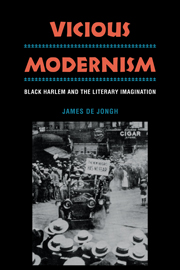Book contents
- Frontmatter
- Contents
- Acknowledgments
- Introduction: Vicious Modernism
- I The Legendary Capital: The 1920s and 1930s
- 1 The Legendary Capital
- 2 City of Refuge
- 3 Crossing the Color Line
- 4 Me revoici, Harlem
- II The Emerging Ghetto: The 1940s and 1950s
- III The Inner City: The 1960s and 1970s
- Epilogue: Black Harlem and the Literary Imagination
- Appendix 1 A Checklist of Black Harlem in Poetry
- Appendix 2 A Checklist of Black Harlem in Novels
- Notes
- Index
- Frontmatter
- Contents
- Acknowledgments
- Introduction: Vicious Modernism
- I The Legendary Capital: The 1920s and 1930s
- 1 The Legendary Capital
- 2 City of Refuge
- 3 Crossing the Color Line
- 4 Me revoici, Harlem
- II The Emerging Ghetto: The 1940s and 1950s
- III The Inner City: The 1960s and 1970s
- Epilogue: Black Harlem and the Literary Imagination
- Appendix 1 A Checklist of Black Harlem in Poetry
- Appendix 2 A Checklist of Black Harlem in Novels
- Notes
- Index
Summary
In its racial transformation, Harlem had become the embodiment of an idea, for by its very existence Harlem posed a challenge to contemporary limits and cultural terms within which personal being for both blacks and whites were imagined and defined. Whether one was a Park Avenue “swell,” exploring the heart of darkness in the comfort of a cabaret, or a black migrant looking for the Promised Land, by the mid-1920s “going to Harlem” was an act fraught with connotations and implications. Not surprisingly, writers of all races were attracted to the theme of Harlem. Yet the physical Harlem of the 1920s was not markedly unlike other sections of New York City. “Physically, Harlem is little more than a note of sharper color in the kaleidoscope of New York,” Alain Locke had observed. Harlem's appeal to writers lay not in its distinctive details of setting but in its power as a sign; consequently, the impulse of the first literary generations employing the motif was to regard black Harlem as a trope, a received cultural artifact for a writer's imaginative re-making, as if only through figurative elaboration could the novel idea of a great black city in the very heart of America's premier metropolis begin to be comprehended and conveyed.
- Type
- Chapter
- Information
- Vicious ModernismBlack Harlem and the Literary Imagination, pp. 15 - 32Publisher: Cambridge University PressPrint publication year: 1990



